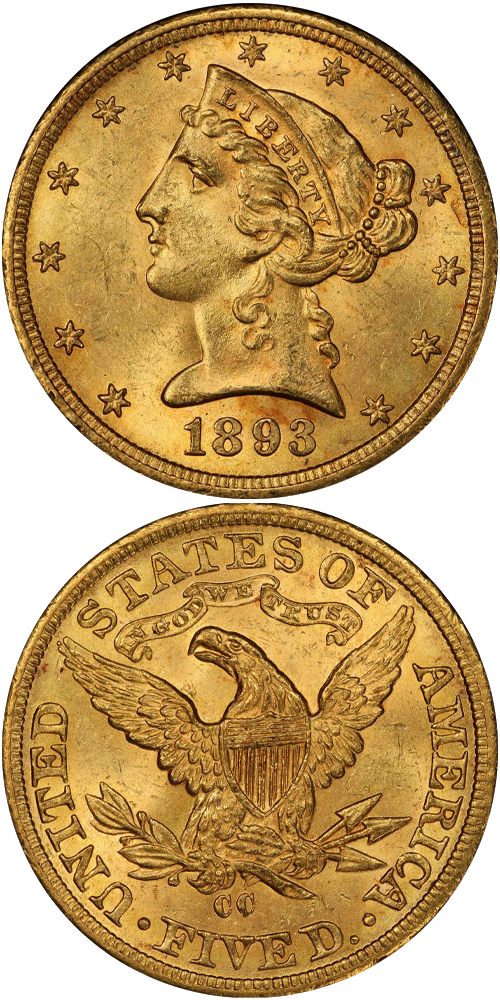1893-CC Liberty Head Half Eagle
Jeff Ambio: The two known die marriages of the 1893-CC five are distinguishable by looking at the date position on the obverse, as both varieties share the same reverse. On examples of the Winter 1-A variety, the date is placed centrally in the field between the base of Liberty's portrait and the denticles.
Rusty Goe: As 1893 began, rumors about the closing of the Carson City Mint split the residents of Nevada into two camps. One side said nothing could stop it from happening; yet the optimists in the state, represented by the Carson Appeal, refused to accept such a fate. When in late May news of the government's decision to close the mint hit Nevada, the Daily Nevada State Journal of May 26 said, "such a result was inevitable."
Despite the impassioned pleadings of the free-coinage people and all the other anti-gold voices, silver's time had ended, at least in this chapter of U.S. history. True, silver deposits at U.S. mints and assay offices had reached record levels in 1892 and 1893. If the need had existed, the Treasury could have ordered its mints to coin millions more silver dollars. This would have kept the Carson branch humming along indefinitely.
The government had never intended to make silver dollars part of its circulating currency. Ever since the Bland-Allison Act had passed in 1878 and had mushroomed into the Sherman Act in 1890, the mints had turned out 420 million silver dollars, of which maybe 60 million were in circulation. The rest remained in Treasury vaults, as backing for the outstanding certificates (currency notes) that the government had used to buy the bullion to make the coins.
Before the government suspended coinage operations in Carson City as of June 1, 1893, Coiner Charles Colburn and his department struck 60,000 half eagles. This mintage figure is the fourth highest in the Carson City branch's history -- the Treasury had again increased half eagle production at all four of its mints.
Approximately one and a half to two percent of the 1893-CC half eagle's original emission survives today. The extant examples, unless heavily abused, are generally well-struck coins, with attractive color and pleasing luster, in grades AU-55 and above. Gem Mint State specimens are rare.
Q. David Bowers: The word rare is again appropriate, with an estimated survival of 300 or so circulated coins (Rusty Goe suggests a higher figure) and Mint State coins plus or minus 100. With relatively few exceptions these are clustered around the MS-60 and MS-61 categories, with some probably more properly being AU-58. Prior to scattered repatriations starting in the 1950s, the 1893-CC was viewed as very rare. Tom Elder, who was in the thick of the numismatic gold market in the 1930s, typically called offerings of the 1893-CC $5 "very rare."
At the cessation of coinage of half eagles in 1893, the total number minted in Carson City stood at 709,617. In Philadelphia the figure was 15,739,161, and in San Francisco 11,490,990. New Orleans, which had made pieces only occasionally, had a figure of just 120,000.
The example to the left was sold by Stack's Bowers Galleries in the Fairmont Collection, Hendricks Set, where it realized $22,800.






